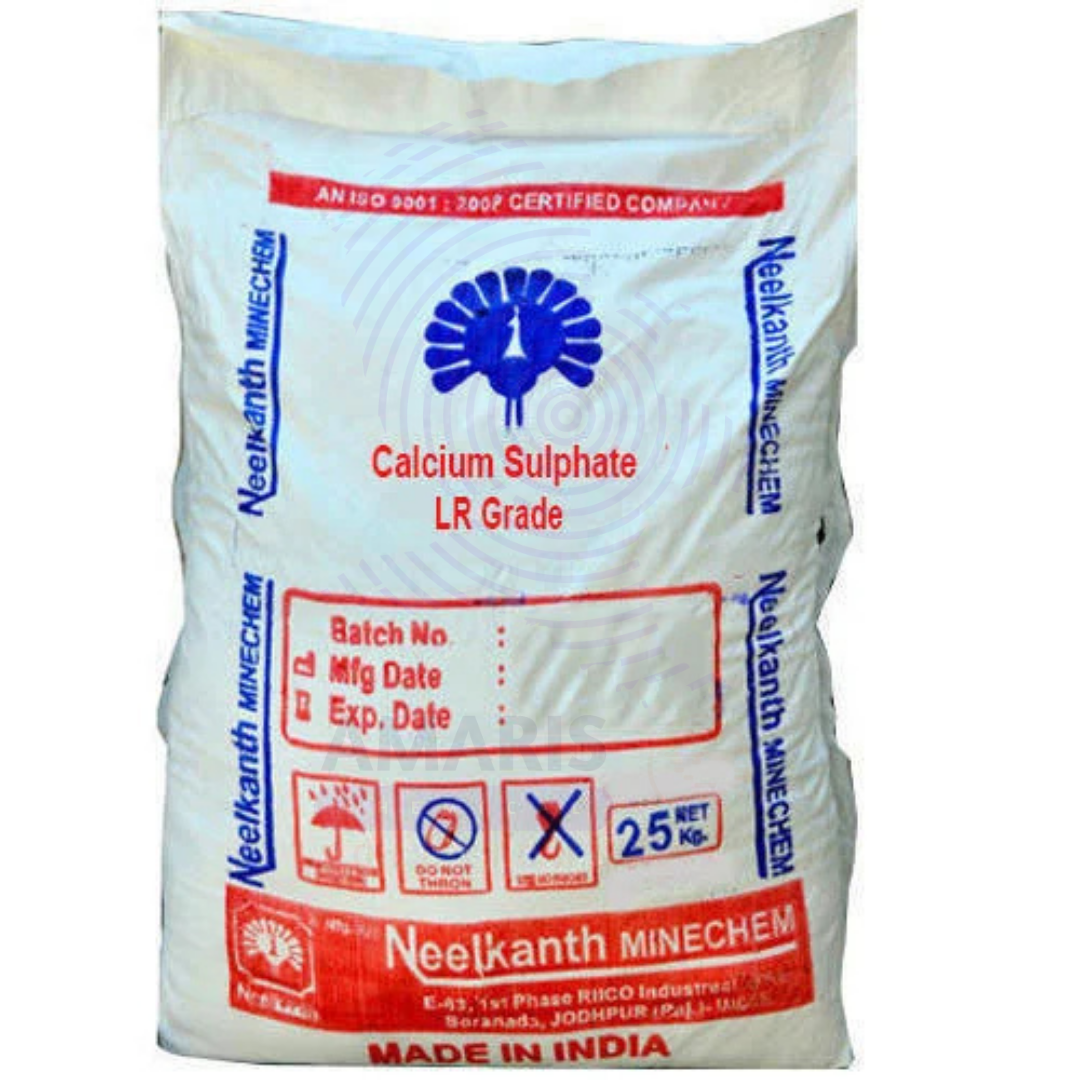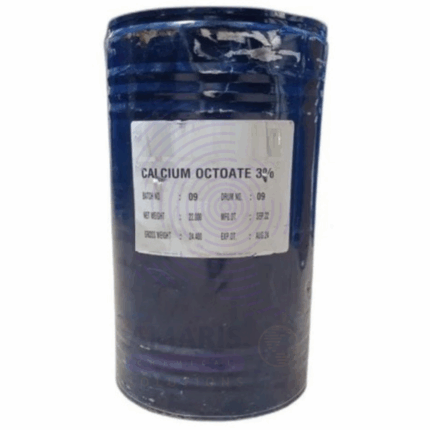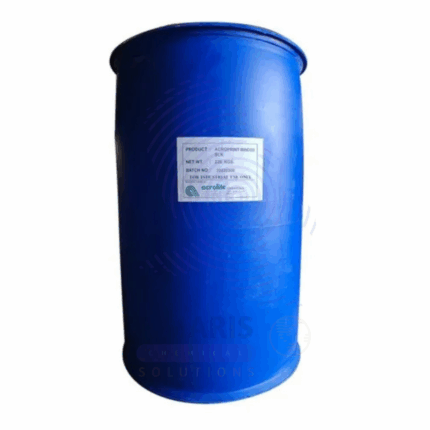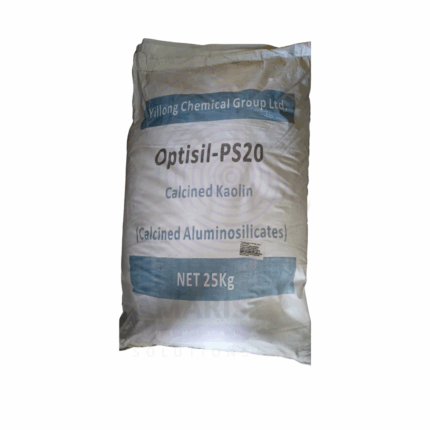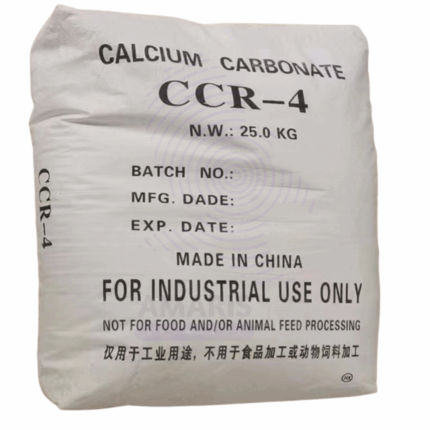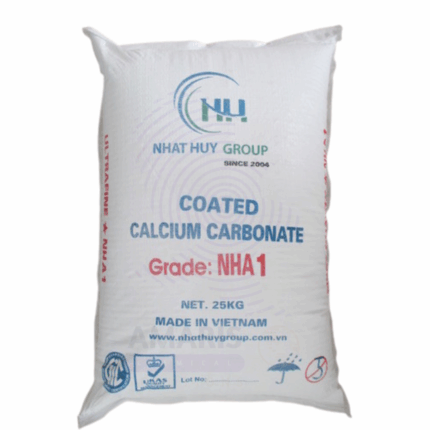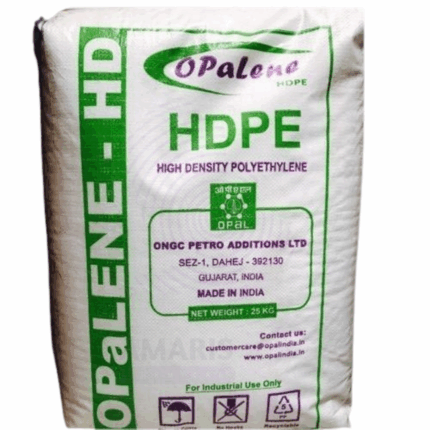Calcium Sulphate
Whatsapp Order
Calcium Sulphate is an inorganic compound composed of calcium, sulfur, and oxygen, commonly found in two forms: dihydrate (gypsum, CaSO4·2H2O) and anhydrous (CaSO4). It appears as a white or off-white crystalline powder or granules with low solubility in water. Calcium Sulphate is widely used in construction, agriculture, pharmaceuticals, food industry, and various industrial applications. It acts as a filler, hardening agent, and drying agent due to its physical and chemical properties. The dihydrate form (gypsum) is notable for use in plaster and cement, while the anhydrous form is often used as a drying agent and in refractory materials.
Description
Table of Contents
Toggle
Calcium Sulphate
Primary Uses
- Construction Industry
- Used as a key ingredient in plaster, plasterboard, and drywall for wall and ceiling finishes.
- Acts as a setting regulator and hardening agent in cement and concrete mixtures.
- Used in soil stabilization and as a component in some types of Portland cement.
- Agriculture
- Applied as a soil amendment to improve soil structure and reduce compaction.
- Supplies calcium and sulfur nutrients to plants, enhancing crop yields.
- Used to reclaim alkaline or sodic soils by improving drainage and nutrient availability.
- Food Industry
- Used as a food additive and firming agent in tofu and canned vegetables (E516).
- Functions as a coagulant in tofu production.
- Used as a calcium supplement in fortified foods and beverages.
- Pharmaceuticals
- Employed as an excipient in tablets and powders.
- Used in medical plasters and orthopedic casts due to its setting and hardening properties.
- Industrial Applications
- Acts as a drying agent (desiccant) in chemical and pharmaceutical industries.
- Used in the production of glass and ceramics.
- Serves as a filler or extender in paints, coatings, and plastics.
Secondary Uses
- Environmental Applications
- Used in wastewater treatment to remove impurities and heavy metals.
- Applied in flue gas desulfurization to reduce sulfur emissions from power plants.
- Art and Craft
- Used in sculpting and mold making as plaster of Paris (calcined calcium sulfate hemihydrate).
- Veterinary Medicine
- Used in animal feed as a source of calcium and sulfur.
KEY PRODUCT FEATURES
1. Basic Identification Attributes
- Chemical Name (IUPAC): Calcium sulfate
- Common/Trade Name: Calcium Sulphate, Gypsum (dihydrate), Anhydrous Calcium Sulfate
- CAS Number: 7778-18-9 (anhydrous), 10101-41-4 (dihydrate)
- HS Code: 2521.00.00
- Molecular Formula: CaSO4 (anhydrous), CaSO4·2H2O (dihydrate)
- Synonyms:
- Gypsum (dihydrate)
- Plaster of Paris (calcined form)
- Anhydrite (anhydrous form)
- Calcium sulphate dihydrate
2. Physical & Chemical Properties
- Physical State: Powder or crystalline solid
- Color & Odor: White or off-white; odorless
- Melting Point: Decomposes above 1450°C (anhydrous form)
- Boiling Point: Not applicable (decomposes)
- Density: Approx. 2.32 g/cm³ (anhydrous), 2.96 g/cm³ (dihydrate)
- Solubility: Slightly soluble in water (~0.2 g/100 mL at 20°C), insoluble in alcohol
- pH (aqueous suspension): Neutral to slightly alkaline (pH 7–9)
- Stability: Stable under normal conditions; sensitive to moisture (anhydrous form hydrates to dihydrate)
3. Safety & Hazard Attributes
- Hazard Class (GHS): Not classified as hazardous
- NFPA Ratings:
- Health: 1 (may cause slight irritation)
- Flammability: 0
- Reactivity: 0
- Exposure Limits: No specific OSHA/ACGIH limits; avoid dust inhalation
- Toxicity: Low toxicity; generally regarded as safe
- Reactivity: Stable; reacts with water (anhydrous to dihydrate conversion)
4. Storage & Handling Attributes
- Storage Conditions: Store in a dry, cool, well-ventilated area
- Container Type: Sealed bags, drums, or bulk containers, moisture-proof packaging preferred
- Shelf Life: Indefinite if kept dry
- Special Handling: Use PPE to prevent dust inhalation; avoid moisture exposure for anhydrous form
5. Regulatory & Compliance Attributes
- FDA Status: Approved for use as a food additive (E516) and pharmaceutical excipient
- EFSA: Approved as a food additive with specific limits
- Transportation: Not classified as hazardous
- Waste Disposal: Dispose according to local environmental regulations
6. Environmental & Health Impact
- Ecotoxicity: Low; naturally occurring mineral with minimal environmental impact
- Persistence: Naturally occurring; biodegradable
- Bioaccumulation: Not expected to bioaccumulate
- Carcinogenicity/Mutagenicity: Not classified as carcinogenic or mutagenic
- Biodegradability: Naturally biodegradable
SAFETY HANDLING PRECAUTIONS
Safety Handling Precautions
Personal Protective Equipment (PPE):
- Gloves
- Dust mask or respirator (for powder handling)
- Safety goggles
- Protective clothing
Handling Measures:
- Avoid inhalation of dust
- Use local exhaust ventilation when handling powders
- Handle in well-ventilated areas
Storage Measures:
- Keep containers tightly closed
- Protect anhydrous form from moisture to prevent hydration
- Store in a dry place away from incompatible substances
Hygiene Practices:
- Wash hands thoroughly after handling
- Do not eat, drink, or smoke while handling the substance
First Aid Measures
- Inhalation: Move to fresh air; seek medical attention if symptoms persist
- Skin Contact: Wash with soap and water; seek medical attention if irritation occurs
- Eye Contact: Rinse immediately with plenty of water for at least 15 minutes; seek medical advice if irritation persists
- Ingestion: Rinse mouth; seek medical advice if large amounts ingested
Firefighting Measures
- Fire Hazards: Non-flammable
- Extinguishing Media: Use water spray, foam, dry chemical, or CO₂ as appropriate
- Special Precautions: Firefighters should wear protective gear and respiratory protection if needed
- Decomposition Products: May emit sulfur oxides under extreme heat
Related products
Binder
A binder is a broad category of substances—organic or inorganic—used to hold different materials together in a cohesive mass. Common binders include natural polymers (starch, cellulose derivatives, proteins), synthetic resins (PVA, acrylics, phenolics), and inorganic binders (clays, cement, lime). They are essential in industries such as pharmaceuticals, construction, coatings, ceramics, adhesives, and printing, where they provide structural integrity, adhesion, and controlled release properties.
Calcined Kaolin
$ 1.20
Calcined Kaolin is a fine, white to off-white powder produced by heating natural kaolin clay to high temperatures (typically between 600°C and 900°C) in a controlled process called calcination. This thermal treatment removes chemically bound water, changes the crystalline structure, and enhances the physical and chemical properties of kaolin. The resulting product exhibits increased brightness, hardness, and opacity, making it highly valuable as a functional additive and filler in numerous industrial applications. Calcined Kaolin is widely used in coatings, ceramics, plastics, rubber, paper, and paint industries to improve durability, brightness, and performance.
Calcium Carbonate Filler
Calcium Carbonate Filler is a high-quality, uncoated ground calcium carbonate (GCC) specially engineered for use as a filler in polyethylene (PE) and other polyolefin resins. This grade of calcium carbonate is designed to enhance the physical and mechanical properties of plastics while providing cost-effective bulk and improved processing. It is a fine, white, odorless powder with excellent brightness, high purity, and uniform particle size distribution. Its use improves stiffness, impact resistance, dimensional stability, and surface finish in polyethylene applications such as films, sheets, pipes, and molded parts.
Coated Calcium Carbonate
Coated Calcium Carbonate is a fine, white, odorless powder consisting of naturally occurring ground calcium carbonate (CaCO₃) treated with a surface coating—typically stearic acid or other fatty acids—to enhance compatibility with non-polar matrices. This coating improves dispersion in plastic and rubber formulations, reduces moisture pickup, and enhances the physical properties of the final product. Compared to uncoated grades, coated calcium carbonate offers better hydrophobicity, improved flow properties, and stronger interfacial bonding in polymeric systems. It is widely used in plastics, rubber, paints, sealants, adhesives, paper, and more.
Eagle Homopolymer 510/50 50%
Eagle Homopolymer 510/50 50% is a high-purity homopolymer solution, typically referring to polyvinyl alcohol (PVA) or a similar water-soluble polymer supplied at 50% concentration. This product offers excellent film-forming, adhesive, thickening, and stabilizing properties, making it versatile in applications such as adhesives, textile sizing, paper coating, and packaging. The homopolymer’s controlled molecular weight and solution viscosity provide consistent performance and ease of handling. The 50% aqueous solution form facilitates easy mixing and incorporation into various formulations.
HDPE Film F52H04 Opalene
HDPE Film F52H04 Opalene is a high-density polyethylene film grade resin specially engineered for producing thin, flexible, and high-strength films. It is designed for blown film extrusion processes, delivering excellent mechanical properties, superior clarity (opal/opalene finish), and consistent gauge control. This resin offers high tensile strength, good puncture resistance, and excellent moisture barrier properties, making it ideal for packaging applications requiring durability and flexibility. Its balanced processing characteristics enable fast extrusion rates and uniform film thickness.
HDPE Injection
HDPE Injection is a high-density polyethylene resin specially formulated for injection molding processes. This grade exhibits excellent flow characteristics with moderate melt flow index optimized for producing precise, high-strength molded parts with superior surface finish. It combines good impact resistance, stiffness, and chemical resistance with excellent dimensional stability. The resin ensures reliable processing performance across a broad temperature range and is suitable for complex, detailed, or large injection-molded components. It is supplied as uniform granules designed for smooth melting and consistent molding cycles.
Masterbatch White PEW60
Masterbatch White PEW60 is a high-quality white pigment masterbatch designed for incorporation into polyethylene (PE) and other polyolefin resins. Containing 60% titanium dioxide (TiO₂) pigment, it provides excellent whiteness, opacity, and brightness to plastic products. PEW60 improves aesthetic appeal and surface finish while maintaining the mechanical properties of the base resin. It is widely used in film extrusion, injection molding, blow molding, and other plastic manufacturing processes to produce a consistent, bright white color.


 Preservatives(food)
Preservatives(food) Flavor Enhancers
Flavor Enhancers Acidulants
Acidulants Sweeteners
Sweeteners Antioxidants
Antioxidants Colorants(food)
Colorants(food) Nutraceutical Ingredients (food)
Nutraceutical Ingredients (food) Nutrient Supplements
Nutrient Supplements Emulsifiers
Emulsifiers
 Collectors
Collectors Dust Suppressants
Dust Suppressants Explosives and Blasting Agents
Explosives and Blasting Agents Flocculants and Coagulants
Flocculants and Coagulants Frothers
Frothers Leaching Agents
Leaching Agents pH Modifiers
pH Modifiers Precious Metal Extraction Agents
Precious Metal Extraction Agents
 Antioxidants(plastic)
Antioxidants(plastic) Colorants (Pigments, Dyes)
Colorants (Pigments, Dyes) Fillers and Reinforcements
Fillers and Reinforcements Flame Retardants
Flame Retardants Monomers
Monomers Plasticizers
Plasticizers Polymerization Initiators
Polymerization Initiators Stabilizers (UV, Heat)
Stabilizers (UV, Heat)
 Antifoaming Agents
Antifoaming Agents Chelating Agents
Chelating Agents Coagulants and Flocculants
Coagulants and Flocculants Corrosion Inhibitors
Corrosion Inhibitors Disinfectants and Biocides
Disinfectants and Biocides Oxidizing Agents
Oxidizing Agents pH Adjusters
pH Adjusters Scale Inhibitors( water)
Scale Inhibitors( water)
 Antioxidants(cosmetic)
Antioxidants(cosmetic) Emollients
Emollients Fragrances and Essential Oils
Fragrances and Essential Oils Humectants
Humectants Preservatives
Preservatives Surfactants(cosmetic)
Surfactants(cosmetic) Thickeners
Thickeners UV Filters
UV Filters
 Fertilizers
Fertilizers Soil Conditioners
Soil Conditioners Plant Growth Regulators
Plant Growth Regulators Animal Feed Additives
Animal Feed Additives Biostimulants
Biostimulants Pesticides (Herbicides, Insecticides, Fungicides)
Pesticides (Herbicides, Insecticides, Fungicides)
 Active Pharmaceutical Ingredients (APIs)
Active Pharmaceutical Ingredients (APIs) Excipients
Excipients Solvents(pharmaceutical)
Solvents(pharmaceutical) Antibiotics
Antibiotics Antiseptics and Disinfectants
Antiseptics and Disinfectants Vaccine Adjuvants
Vaccine Adjuvants Nutraceutical Ingredients (pharmaceutical)
Nutraceutical Ingredients (pharmaceutical) Analgesics & Antipyretics
Analgesics & Antipyretics
 Analytical Reagents
Analytical Reagents Solvents(lab)
Solvents(lab) Chromatography Chemicals
Chromatography Chemicals Spectroscopy Reagents
Spectroscopy Reagents microbiology-and-cell-culture-reagents
microbiology-and-cell-culture-reagents Molecular Biology Reagents
Molecular Biology Reagents Biochemical Reagents
Biochemical Reagents Inorganic and Organic Standards
Inorganic and Organic Standards Laboratory Safety Chemicals
Laboratory Safety Chemicals Specialty Laboratory Chemicals(Special Laboratory Equipment)
Specialty Laboratory Chemicals(Special Laboratory Equipment)
 Demulsifiers
Demulsifiers Hydraulic Fracturing Fluids
Hydraulic Fracturing Fluids Scale Inhibitors(oil)
Scale Inhibitors(oil) Surfactants(oil)
Surfactants(oil) Drilling Fluids
Drilling Fluids
 Dyes and Pigments
Dyes and Pigments Bleaching Agents
Bleaching Agents Softening Agents
Softening Agents Finishing Agents
Finishing Agents Antistatic Agents
Antistatic Agents
 Admixtures
Admixtures Waterproofing Agents
Waterproofing Agents Sealants and Adhesives
Sealants and Adhesives Curing Compounds
Curing Compounds Concrete Repair Chemicals
Concrete Repair Chemicals Anti-Corrosion Coatings
Anti-Corrosion Coatings
 Surfactants(cleaning)
Surfactants(cleaning) Builders
Builders Enzymes
Enzymes Solvents (Cleaning)
Solvents (Cleaning) Fragrances
Fragrances
 Electronic Chemicals
Electronic Chemicals Catalysts
Catalysts Lubricants
Lubricants Photographic Chemicals
Photographic Chemicals Refrigerants
Refrigerants Automotive chemicals
Automotive chemicals Pyrotechnic Chemicals
Pyrotechnic Chemicals
 Biodegradable Surfactants
Biodegradable Surfactants Bio-based Solvents
Bio-based Solvents Renewable Polymers
Renewable Polymers Carbon Capture Chemicals
Carbon Capture Chemicals Wastewater Treatment Chemicals
Wastewater Treatment Chemicals
 Pigments
Pigments Solvents(paint)
Solvents(paint) Specialty Coatings
Specialty Coatings Binders/Resins
Binders/Resins Additives
Additives Driers
Driers Anti-Corrosion Agents
Anti-Corrosion Agents Functional Coatings
Functional Coatings Application-Specific Coatings
Application-Specific Coatings
 Fresh Herbs
Fresh Herbs Ground Spices
Ground Spices Whole Spices
Whole Spices Spice Blends
Spice Blends Dried Herbs
Dried Herbs
 Leavening Agents
Leavening Agents Dough Conditioners
Dough Conditioners Flour Treatments
Flour Treatments Fat Replacers
Fat Replacers Decoratives
Decoratives Preservatives(baking)
Preservatives(baking)
 Plasticizers & Softeners
Plasticizers & Softeners Reinforcing Agents
Reinforcing Agents Adhesion Promoters
Adhesion Promoters Vulcanizing Agents
Vulcanizing Agents Antidegradants
Antidegradants Blowing Agents
Blowing Agents Fillers & Extenders
Fillers & Extenders Accelerators & Retarders
Accelerators & Retarders